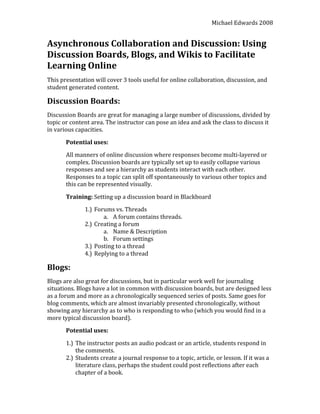
Asynchronous Tools Discussion Boards Blogs Wikis
- 1. Michael Edwards 2008 Asynchronous Collaboration and Discussion: Using Discussion Boards, Blogs, and Wikis to Facilitate Learning Online This presentation will cover 3 tools useful for online collaboration, discussion, and student generated content. Discussion Boards: Discussion Boards are great for managing a large number of discussions, divided by topic or content area. The instructor can pose an idea and ask the class to discuss it in various capacities. Potential uses: All manners of online discussion where responses become multi‐layered or complex. Discussion boards are typically set up to easily collapse various responses and see a hierarchy as students interact with each other. Responses to a topic can split off spontaneously to various other topics and this can be represented visually. Training: Setting up a discussion board in Blackboard 1.) Forums vs. Threads a. A forum contains threads. 2.) Creating a forum a. Name & Description b. Forum settings 3.) Posting to a thread 4.) Replying to a thread Blogs: Blogs are also great for discussions, but in particular work well for journaling situations. Blogs have a lot in common with discussion boards, but are designed less as a forum and more as a chronologically sequenced series of posts. Same goes for blog comments, which are almost invariably presented chronologically, without showing any hierarchy as to who is responding to who (which you would find in a more typical discussion board). Potential uses: 1.) The instructor posts an audio podcast or an article, students respond in the comments. 2.) Students create a journal response to a topic, article, or lesson. If it was a literature class, perhaps the student could post reflections after each chapter of a book.
- 2. Michael Edwards 2008 3.) Students post pictures they’ve taken in a photography class; other students respond with critiques and feedback. Blog Training: Creating a blog and posting content to it. 1.) Blogs can be easily obtained from sources such as Wordpress and Blogspot. 2.) Posting an entry / Editing an entry 3.) Uploading a picture or an other file 4.) Various settings: access, users, comments, sidebar links Wikis: Like Wikipedia, host pages whose content is designed to be revisable, edited, expanded upon, and interlinked with other Wiki pages. Since wiki pages can be dynamically added and edited on‐the‐fly, learning can be more spontaneous. Potential uses: 1.) Lesson summaries a. When the student has completed a lesson, they are asked to summarize it in a wiki post. After all the students have accomplished this, they could optionally be combined into one large compendium of information. 2.) Collaboration of notes a. Students could, of their own initiative or not, work alone or together in the creation of notes to make sense out of large amounts of course information. While some students may contribute little (i.e. “bottom feeders”) they will never retain as much as the students that put in the work editing and adding to the page. b. You might describe this as creating a “little wikipedia.” 3.) Concept introduction and exploratory projects a. If the class encounters a topic that interests them, or a concept they don’t fully understand, they can immediately create a wiki page for it as they explore. The wiki page will then house all the information they gather and compile. b. Example: What is a mashup? http://westwood.wikispaces.com/Mashup+Madness 4.) Dissemination of important classroom information a. FAQ guides regarding various important topics could be put together as‐a‐class or ahead of time for the class. b. http://westwood.wikispaces.com/Chapter+1+‐ +Security+and+Privacy 5.) Individual Assessment Projects a. Assign students an assignment that will encompass a variety of information gathering and analysis. For example, suppose they
- 3. Michael Edwards 2008 were to research and advise a relative on a computer purchase, considering various topics. b. http://westwood.wikispaces.com/Scenario+1 Wiki Training: Creating a wiki: http://demonstrationclass.pbwiki.com/ 1.) Creating an education wiki from pbwiki.com 2.) Editing the front page 3.) Adding other pages 4.) Editing the sidebar 5.) Uploading pictures and other files Which tool should I use? Most of these tools are variations on a theme. Certain users (sometimes all) are able to variably create or edit chunks of text and possibly adding comments about that text. Users might be able to re‐organize these chunks, determine access to them, and more. Source: http://www.tltgroup.org/OLI/blogworkshop/FirstQuestions.htm Cognitive learning principles encompassed in this training session, if properly given in a computer lab with handson potential for the audience: 1.) Content. Teach both heuristic (“tacit”) knowledge as well as textbook knowledge. It’s easy to take tacit knowledge for granted. 2.) Situated learning. Teaching knowledge and skills in a way that reflects how it will be used in real life. 3.) Modeling and explaining. Show how a process unfolds and tell why it happens so. 4.) Coaching and feedback. Observe students as they try tasks and provide hints and help when needed. This helps personalize attention to performance. 5.) Scaffolding and fading. Start out by demonstrating tasks, but gradually fade out the demonstrations as students take initiative to learn for themselves how things work. 6.) Sequence. Proceed in order from simple to complex. Source: http://carbon.cudenver.edu/~bwilson/training.html